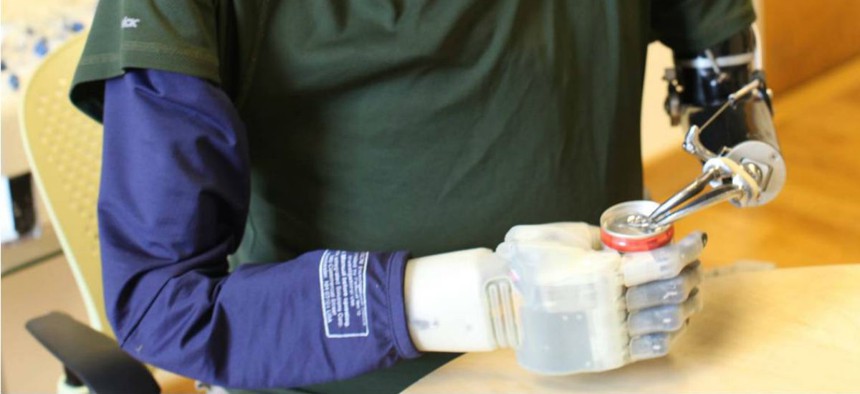DARPA's Ex-Leader's Speculative Dream of Mind-Melding Empathy

A participant in DARPA's Revolutionizing Prosthetics program tries opening a can. DARPA
Arati Prabhakar imagines a neurologically enhanced future where everyone’s brains are connected.
The former head of the Defense Advanced Research Projects Agency, Arati Prabhakar, has a dream. It’s a civilian utopian neuroscience dream that’s kind of the inverse of the scenarios the far-out research wing of the military normally develops.
In a presentation at the Aspen Ideas Festival, which is co-hosted by the Aspen Institute and The Atlantic, she’d just shown a video from University of Utah research in which a soldier who’d lost his arms “felt” a virtual door through neural stimulation.
She cautioned the research was very new and “not yet a robust capability, but even at this stage, we can start to see that there will be some mind-bending questions about how we use these technologies in the future.” Prabhakar noted from a technological point of view, “there’s not much distance from restoration to enhancement.”
She asked the audience: “Do you think the future we’re going to live in a society where neuro-enhancements will be a privilege? Will they be a right? Might they be a mandate? Or maybe the whole idea is gonna creep us out so much that we won’t want anything to do with it.”
Mandated neuroenhancements certainly seem creepy to me!
Dispatches from the Aspen Ideas Festival/Spotlight HealthRead more
“But imagine if you could learn a new language as fast as a 6-year-old,” she continued. “Or imagine if you could experience a whole new palette of colors or a fourth physical dimension in space.”
I’m not even sure what that means, but I would most definitely want to experience a fourth physical dimension in space.
But then she delivered the true utopian dream:
“Imagine if we could connect among ourselves in new and deeper ways and imagine if those connections happened in a way that gave us so much empathy and understanding of each other that we could put our minds together, literally, to take on some of the world’s hardest problems.”
She did not expound on the image, but one imagines she’s thinking about a kind of direct brain-to-brain interface.
DARPA has, after all, invested a lot in direct electronic brain interfaces. In one research program, it's working on “intuitive” neural interfaces for controlling prosthetic limbs. In another, it's creating “an implantable neural interface able to provide advanced signal resolution and data-transfer bandwidth between the brain and electronics.” The goal there is to create a translator between “the electrochemical language used by neurons in the brain and the ones and zeroes that constitute the language of information technology.”
And once you’ve got intuitive neural controls and a translator that lets you send brain signals into computers and back again, it does not seem an incredible leap to hook two (or … a million?) humans up together.
“If we could get to that future, we would look back at today’s reality and it would look like black and white,” Prabhakar said. “It would look like flatland.”
It’s a pretty fascinating speculative fiction. Compelling, perhaps, but also repulsive. And, if we can use recent history as any guide, wiring humans together in ever tighter communication loops doesn’t always turn out so well.



